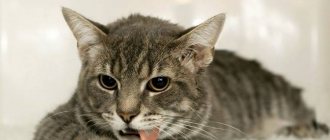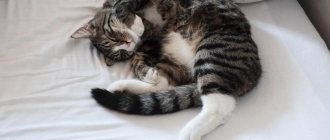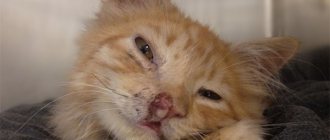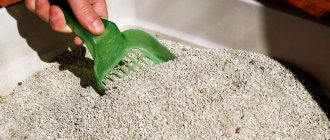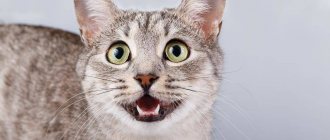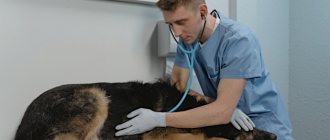There are certain rules when our beloved pets become ill and have to resort to tablets, capsules, powders, various mixtures and injections. But in practice, not everything is so simple and injections are not so scary. And how should the oral administration of medications be carried out correctly?
Let's start with the cases in which medications should not be given. When our pet:
- vomit;
- difficulty breathing;
- damaged neck muscles and skull bones;
- intestinal obstruction, constipation for many days, when there is a risk of complete blockage of the intestine or when a foreign body is suspected;
- painful lesions in the oral cavity.
If our four-legged dog does not have all this, and the veterinarian has given the go-ahead, we will administer medications orally (orally through the mouth) to our pet:
- When the animal sits in the sphinx position, it reduces the risk of medications entering the pet's respiratory tract.
- Under no circumstances should dry powder mixtures be poured into the animal’s mouth.
- It is best to ask your veterinarian how to administer the medication to your animal.
- Be sure to monitor the dosage of medications; not every drug can be used on kittens.
- Never give liquid medications to cats lying on their backs.
- When administering medicine, foam often forms in the mouth, this is profuse salivation - it is not critical, this effect is produced by bitter or sour medicines.
Method 1: Add to food
Don't try to trick your cat by slipping pills into her food. There is a high probability that the animal will spit out the drug, which is in its entirety, and eat only the yummy. There is only one way out - the powdered state of the medicine. But remember - not all medications are taken with food. The main thing is:
- Waiting until the cat gets hungry is to our advantage, since its taste buds will be dulled at the very beginning.
- Mix our powder with a small portion of food, but there is a chance that our pet will leave some in the bowl.
First way
One of the options is that the most important thing is for us to prepare so that our mustachioed friend does not suspect anything. Take the medicine, prepare a syringe with drinking water without a needle, you can try to sit the animal in front of you or pick it up in your arms. This is done to keep the animal calm - look at the character of your pet. With one hand you will need to unclench the jaws, and with the other we push the medicine onto the root of the tongue on the side as deeply as possible. Perhaps use an introducer. And we close our mouths for a short while, stroking our chin from top to bottom to stimulate the swallowing reflex. When we see that the animal has swallowed the medicine, we place a syringe with pre-drawn water behind its cheek. Don’t get your hopes up - you may get resistance from the animal and will have to repeat the whole procedure several times, since this method is for one person.
Second way
This method differs in that you carry out this procedure together - one person holds our shaggy patient so that he is fixed, having first grabbed him by the scruff of the neck and tilted his head back. The other pushes the medicine and gives it to the animal to drink. To secure it, you can try wrapping the lower part of the body in some kind of sheet or other dense fabric, so as not to damage it or the person holding it.
Treatment of drug intoxication
The basis of treatment is drug withdrawal. Neurological symptoms are of great importance in diagnosing the condition. The drug and its breakdown products are eliminated through all excretory organs: intestines, kidneys, saliva, sweat glands. The main routes of elimination are the kidneys and liver. Toxins are eliminated from the kidneys quickly enough and are eliminated in the urine. The situation is more complicated with drugs that are eliminated through the gastrointestinal tract.
From the liver cells, the breakdown products of the drug enter the bile and end up with it in the intestines, where they can be reabsorbed and delivered to the liver. This process is called enterohepatic circulation of substances. In some cases, harmful substances are excreted from the intestines along with feces. Circulation can result in toxins remaining in the body for quite a long time. This creates a high load on the liver, provokes the activity of liver enzymes and unpleasant symptoms.
But the entry of drugs and their breakdown products into the stomach, as well as their further movement through the intestines, does not pass without a trace. Peristalsis is disrupted, mucous membranes are irritated, and an imbalance of bacteria occurs. For example, many antibiotics have a detrimental effect on the intestinal microflora. Frequent, prolonged use or an inadequate dose can lead to intoxication. You can speed up their removal with the help of sorbents.
It is important to understand that many mild symptoms of intoxication are an attempt by the body to independently remove excess substances. There is no need to interfere with these processes if they proceed in moderation. It is best to provide conditions under which natural cleansing will occur. For example, with moderate vomiting, you should not resort to the use of antiemetic drugs. You should sound the alarm if your temperature rises above 38.5 °C, uncontrollable vomiting that interferes with fluid intake, signs of dehydration and frequent diarrhea.
Treatment of drug poisoning is carried out using several methods:
- gastric and intestinal lavage (according to indications);
- intravenous infusions to accelerate the elimination of toxins, replenish lost fluid due to diarrhea and vomiting. This technique is appropriate for acute forms of intoxication, in a hospital setting;
- prescribing enterosorbents for internal use to bind and remove toxic substances;
- use of enzyme preparations and diuretics according to indications;
- the use of probiotics and prebiotics to restore normal intestinal microflora;
- vitamin therapy and antioxidant treatment to neutralize free radicals.
For chronic intoxications, outpatient treatment is allowed. But it is important to consult a physician to find out the exact cause of poisoning, adjust the dosage of regularly used medications, or choose an alternative.
In the future, you can cope with the elimination of toxic substances with the help of plenty of drinking, a gentle diet, and enterosorbents. One of the effective drugs to combat intoxication is Fitomucil Sorbent Forte. The product contains a plant sorbent, inulin - a prebiotic that promotes the growth of its own beneficial microflora, as well as live bacteria. The drug accelerates the elimination of harmful substances and improves motility of the gastrointestinal tract. It has a gentle effect on the gastrointestinal tract and does not cause bloating or abdominal pain.
Method 2. Give in powder
Let's look at this point, since some animals will reject any medications to the point of going on hunger strike, and our only option in this case is to grind the tablet to a powder state.
How to use the pill dispenser
The tablet dispenser is not so scary - it consists of a soft nozzle at the end of a plastic syringe and is suitable for both tablets and capsules of different sizes, but to the extent of our pet’s mouth.
The instructions are simple - we place a tip with water previously drawn inside onto the tip of the syringe, insert a tablet and, with the prepared patient with his head thrown back and his mouth open, place the device at the base of his tongue, gently press the syringe plunger, thereby squeezing out the tablet or pill, and give the opportunity Gently wash down the medicine with the remaining water in the syringe.
When can it be mixed with food?
Remember that cats are very sensitive to aromas and will not eat a strong smell of medicine; to do this, you will have to resort to deception. For example, prepare a mini-meatball, the size of a bean, from minced turkey, beef, lamb, etc., but in no case from pork and chicken, since they often contain eggs of intestinal parasites and pathogenic bacteria, such as salmonella, but you can find out this in a separate article.
If this method does not work, mix the medicine with a minimum portion of sour cream. It will definitely be eaten.
When not to mix with food
The most important thing is to always check with your veterinarian whether the drug can be mixed with water or milk, since this or that medicine cannot always be mixed with food. And remember what was said above, how to properly use the drug for a cat.
Symptoms of drug intoxication
Symptoms of drug poisoning can be very different; the manifestations are mainly determined by the type of drug. A distinctive feature of drug poisoning is its detrimental effect on the central nervous system. Common symptoms include weakness, lethargy, decreased reaction time, or severe psychomotor agitation. Cases of loss of consciousness are known in practice.
One of the common symptoms includes severe headaches. They can even be triggered by hormonal agents, especially if the patient has a predisposition to periodic headaches. When taking hormones, compensatory mechanisms are disrupted, which normally maintain the absence of symptoms. This occurs when taking a large dose of drugs containing caffeine, nitrates, hydralazine, bronchodilators, etc.
An overdose of antibacterial drugs is often accompanied by negative manifestations from the gastrointestinal tract: diarrhea, abdominal pain, increased gas formation. For example, an overdose of penicillin antibiotics leads to rash, vomiting, and convulsions. Excess chloramphenicol can cause heart failure.
Symptoms of poisoning with drugs used to normalize cardiovascular function include:
- heart rhythm disturbance;
- spasms and bradycardia;
- gagging.
An overdose of nonsteroidal anti-inflammatory drugs affects the central nervous system: depression of consciousness, lethargy, lethargy, sleep disturbances, etc. are observed. The use of large amounts of antihistamines (decongestants, antiallergic) drugs can provoke weakness, dilated pupils, hallucinations, and psychomotor agitation.
Poisoning with tranquilizers is dangerous due to disturbances in heart rhythm, suppression of central nervous system function and respiratory disorders, convulsions, severe tremors of the limbs, and hallucinations. The patient's speech may be incoherent and slurred.
It is important to understand that manifestations depend not only on the presence of a particular active substance in the blood, but also on its concentration. Even traditionally beneficial components, such as vitamins, can be harmful and lead to the need for detoxification. What one person can easily endure, another will endure with a whole range of unpleasant manifestations.
How to give a cat a large tablet?
Sometimes it happens that animals are prescribed human pills, and since they are not intended for animals, most often they are large. And we have a question about using the pill. How to solve this big problem with such a tablet. They are distinguished by their bitter taste and size. Don't worry, there are options that we have already touched on today. Grind the tablet to a powder and give it in small portions with food or water. Most importantly, do not try to shove a large pill into the animal. Even if you succeed and he swallows it, there is a 100% chance that he will vomit this pill - this is due to his digestive system.
But there are other techniques, for example, hanging by the withers by inserting your finger in the area of the cat’s lower jaw, but prepare first if you don’t want your pet to bite your finger.
Collecting information
If you are treating a pet and have been prescribed pills, I recommend that you immediately ask your veterinarian:
- is it possible to replace the medicine with a suspension or injections;
- Is it possible to crush the tablet and give it to the animal in powder form?
- Is it permissible to mix the medication with food?
The specialist will, of course, provide you with the necessary information. But you won’t run to the veterinary clinic for details if something suddenly doesn’t go according to plan. In any case, there are alternative options for taking the drug that are easier and less traumatic for both the cat and the owner. Let's look at and discuss them in detail.
How to give liquid medicine to a cat?
Let's delve deeper into what we can mix with and how to give the medicine in liquid form. It can be mixed not only with milk and water, but also with yolk, meat or softened food. This all depends on the medication and advice from your veterinarian. In liquid form, it is best taken orally through a syringe.
- Let's prepare a syringe by first filling it with medicine with a liquid component.
- We prepare the furry household member in advance and fix its body.
- We insert the syringe between the cheek and teeth, the most important thing is that pushing the syringe deep into the mouth is strictly prohibited.
- Controlling the serve with one hand, without throwing your head back high, raise it.
- And with the second hand we carefully begin to administer the medicine, so that the household member has time to swallow it.
Remember that liquid medication may be inhaled, so release your pet immediately and allow him to cough.
And one more thing - liquid medicine is always more difficult to give than a tablet. It is better to carry out this procedure with the help of family members or friends.
Read the instructions or ask your veterinarian
Before proceeding with the main part of the procedure, you should carefully read the instructions for the drug or ask your veterinarian the following questions:
- Is it possible to mix tablets with water?
- Is it permissible to grind the product into powder;
- Will it be possible to dissolve the tablet in water?
- Is it possible to add the drug to fatty foods, for example, meat, sour cream or milk;
- If the product is in liquid form, does it lose its properties if it is diluted a little with water?
In what position and how to make a cat eat a pill is best
The most important thing is to look at the most comfortable fixation for you and the chosen fixation position for the cat. Not upside down, since the cat will not be able to swallow anything and, given the resistance and dexterity of our pet, will not lead to stress on both sides.
Important! If you are not confident in your abilities and your attempts turned out to be a failure, seek help from specialists.
How to open a cat's mouth to give a pill?
Let's turn to cat physiology for this. When we lift her by the withers with one hand, her mouth will reflexively open, which will help us in her treatment, to give her a pill and then, holding her mouth with our hands and not opening it, gently blow into her nose so that the cat swallows the pill .
To alleviate all the stress she's been through, it's best to give her her favorite treat and water so nothing gets stuck somewhere in her esophagus.
We can also try to minimize stress or avoid it altogether if we can find a drug that dissolves well without sediment and it makes more sense to inject it orally through a syringe.
In order for the animal to swallow the medicine, but at the same time it shows with all its appearance that it does not plan to swallow it and there is a possibility that it is holding it somewhere on the root of the tongue, it is best to gently stroke it from the Adam’s apple to the chest so that the swallowing reflex is triggered.
When is the best time to give your cat pills?
Pills are given in the following situations:
- Long-term use of antibiotics is required. After 4 days, all the paws will be punctured, it will be painful for the cat to walk, so the doctor prescribes pills.
- With quarterly dewormings: tablets expel tapeworms and roundworms.
- To protect pets from fleas, ticks, and worms. Unlike drops on the withers, you do not need to wait for the toxic liquid to be absorbed. You can give tablets to several animals at once.
The medicine is fed in the morning on an empty stomach or between feedings, unless the instructions indicate otherwise.
What should you do if your cat struggles, resists, and spits out the medicine?
With the active persistence of our household and if our efforts have not led to the proper result of consuming the desired liquid and everything ends up on the floor, it is best to contact a specialist, although if at a certain period of time this option is difficult, then a video on a specific topic or a similar article can help.
How to restrain a four-legged patient?
There are two ways. And both of them are recommended to be done together, since one person wraps the pet in a blanket, towel or other thick fabric and holds it accordingly, and the second gives it the medicine. The second method does not require auxiliary tissue elements, but involves taking the pet by the withers and holding the pet’s limbs with the other hand. And the owner at this time gives medicine to the pet.
What is important to consider when giving your pet medication?
To properly medicate your cat without stressing it out, it is important to consider the following:
- the cat should be calm, that is, it is not recommended to pester the animal after trips, guests, etc. Only actions and surroundings that are familiar to the animal are suitable;
- All manipulations must be done confidently and quickly so that the animal does not have time to get scared. Fear manifests itself as follows: the pupils sharply dilate (the eyes become black, almost entirely), a large amount of hair falls out profusely, the paw pads begin to sweat, leaving wet marks, breathing quickens and becomes noisy. If such a condition occurs, you should immediately stop all manipulations, provide the animal with access to water and monitor the condition. If the symptoms do not stop, and the mucous membranes (better visible in the mouth) begin to turn blue, you need to go to the veterinarian;
- the animal must be well restrained. This may require the help of a family member. It is necessary to ensure that the fixation is correct and does not harm the cat’s health. It is important to remember that the effort applied must be comparable to the resistance of the animal;
- You should definitely make sure that the cat swallowed the tablet and that it did not come out with saliva. But there is no need to try to shove it in by any means;
- making a cat eat a tablet as if it were a treat will never work;
- you need to know whether the drug is bitter in order to choose the right method of administration.
You can’t just throw medicine into your mouth
Precautionary measures
In the choice of medications.
In any case, consultation with a specialist is important. Do not change dosage or medications to other similar current medications without first consulting your veterinarian.
Do not be tempted by cheap analogues of the medications prescribed for your pet. They can be either ineffective or harmful.
When regularly deworming your animal:
- The cat must feel well, otherwise the risk of complications is high.
- Watch the quality of the chosen drug so that there are no complications.
- If signs are bad, contact your veterinarian.
- Pregnant and lactating cats are not recommended to take such drugs.
- Take breaks between taking such medications so that your pet's body has time to recover.
Can I give the tablet with food?
Effective treatment of the disease requires full compliance with the doctor’s instructions and the rules for taking medications. Therefore, an important step towards your pet’s recovery is to take the medication at a strictly specified time. In addition, how much of the drug a cat needs for a specific disease and individual indicators is decided by the veterinarian.
Not all medications can be combined with meals. There are some physiological and pharmacological reasons why medication should not be administered with food.
The medicine is prescribed on an empty stomach if the remedy should not be exposed to excessive hydrochloric acid.
Capsules, as a rule, can be taken regardless of food intake, since the capsule protects the active substances of the drug from the aggressive environment of the stomach. In most cases, this form of medication is active in the intestines - the capsule dissolves and the medicine is absorbed into the bloodstream.
Some drugs are not recommended for use with food, as they have a pronounced bitter taste.
Some medications are recommended for use during or after meals, for example, Amoxicillin for colds of bacterial origin, as well as some medications aimed at treating urolithiasis in cats.
Recommendations from veterinarians
Most veterinarians advise that since taking medications for four-legged pets is stressful, it is best to contact specialists, veterinarians, who will help simplify this procedure. And:
- There is no need to shout at animals - they will not understand you, but they will feel your emotions.
- Never prepare medicines in front of an animal, as they will remember it.
- Injuries often occur, so it’s best to keep disinfectants on hand.
- Be confident in yourself and in such procedures for the peace of mind of your pet if they occur regularly.
- In addition to tablets and powders, there are also pastes and suspensions, as well as solutions for injections. Your veterinarian may be able to advise you on a method of taking the drug that is more convenient for you and your pet and the consistency of the drug itself.
- Placing your pet on a table under a soft blanket for his comfort and comfort will play an important role.
Now, after reading this article, you know several alternatives for affordable and most gentle techniques for administering medications to your furry friend. The main thing is to learn to always remain calm, carefully and promptly respond to your pet’s reaction to the specific medication option you have chosen.
Crushed tablet or powdered preparation
Antihistamines for cats: what to give for allergies
If it is necessary to give powdered medicine or it is possible to crush the tablet, then the powder can be diluted with water (in a small amount) and mixed well. There are two ways to give your cat medicine. The first is to place the resulting suspension in a tablet dispenser (it has a compartment for liquid medications) or in a regular syringe without a needle. Then, according to the principle described above, placing it deep in the mouth, inject the contents into the cat’s throat.
The second method only works if the resulting liquid tastes sweet (yes, this also happens). The solution is simply poured into an empty bowl or onto food and offered to your pet. It is very important that the medicine is not bitter, otherwise, in the future, the cat may begin to refuse food.
Any of the proposed methods for giving cats different tablets is effective and proven in practice. By choosing the most suitable one, you can cope with the task without visiting a veterinary clinic.
How to give anthelmintics to a kitten
A kitten can only be given anti-worm medication from three weeks of age. After the first deworming, it is necessary to repeat the procedure 10 days later.
As a rule, it is easier for a kitten to carry out such activities than for an adult animal.
- The medicine in tablet form can be crushed to form a powder, which should be carefully poured from a piece of paper into the baby’s mouth. It is better to keep the kitten on your lap while lying on its back.
- Second option: the tablet is diluted with a small amount of water. Give from an insulin syringe, from which the needle must first be removed.
- It is easier to administer the suspension to a kitten together. One carefully holds the baby so that he does not twitch. And the second, raising his upper lip, gradually injects the medicine from the side. Then you need to stroke the animal’s neck from top to bottom.
Features of cat behavior
Normal behavior for a cat is to refuse medications. If a cat actively resists attempts to feed it tablets, then this indicates its health. Passive behavior and calm use of medicine are a sign of illness.
If the owner has little experience and finds it difficult to feed the cat a tablet, then it can be replaced with drops, a suspension or even an injection. At the pharmacy, you can ask whether the medicine prescribed for your pet is available in other forms.
The younger the animal, the easier it is to give medicine. It seems that it will be more difficult to get a pill into their small mouth, but kittens are more flexible than adult animals.
If a cat is regularly given anthelmintic drugs from infancy, then with an adult animal there will be less hassle in this matter in the future.

